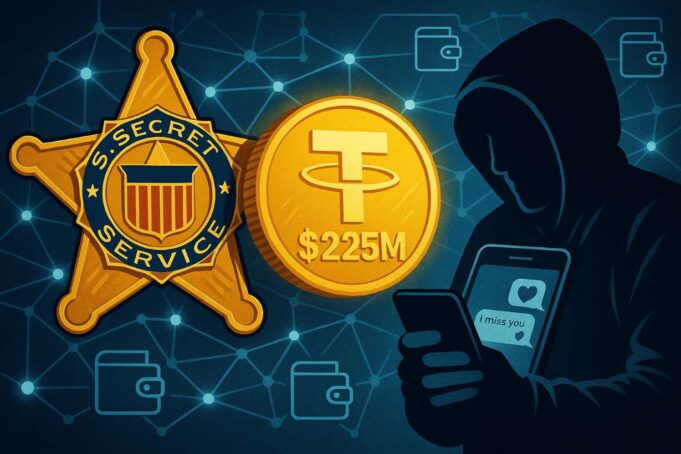In a historic enforcement action, the U.S. Secret Service has seized $225 million worth of Tether (USDT) linked to a global pig butchering scam, marking the largest crypto recovery of its kind. Investigators tracked illicit transactions across hundreds of wallets, not least with critical forensic support from Coinbase. What they unraveled was a complex network of transnational crypto fraud. This USDT seizure reflects growing cooperation between centralized exchanges like Coinbase and federal agencies in targeting crypto-enabled financial crimes.
What Is a Pig Butchering Scam?
The pig butchering scam, a term derived from Chinese slang, blends romance, investment, and psychological manipulation. Victims are “fattened up” over weeks or months through fabricated relationships, often via dating apps or social media. Once they secured the trust, scammers encourage victims to invest in fraudulent crypto platforms or send assets directly. When the victims try to withdraw funds, they’re locked out, their investments gone.
Sadly, such romance scam schemes have surged globally, targeting elderly individuals, young professionals, and even experienced investors.
The $225 Million Crypto Seizure
Federal investigators traced the $225 million in crypto to a fraud ring spanning multiple jurisdictions. The U.S. Department of Justice (DOJ), in partnership with the U.S. Secret Service, filed a formal crypto forfeiture complaint to seize the funds held in Tether wallets. According to the filing, they consolidated the funds from thousands of victims defrauded through fake investment platforms.
Law enforcement froze the wallets after flagging them using blockchain analytics and live tracking tools. The Secret Service executed its crypto crackdown across multiple states and coordinated with foreign counterparts, signaling the scam’s international scale.
How the Scam Was Orchestrated
The fraud ring is believed to be operated by organized crime syndicates based in Southeast Asia and China. Scammers exploited anonymity tools like mixers, decentralized platforms, and proxy wallets to obfuscate the origin of funds. However, investigators observed these rapid fund movements, layering transactions to avoid detection.
Despite employing such a sophisticated laundering network, they couldn’t escape modern crypto asset tracing tools. Smart contract anomalies and wallet clustering flagged the activity as part of a high-risk fraud pattern.
Coinbase’s Role in the Crackdown
Coinbase directly supported law enforcement through its compliance and investigations unit. The exchange used proprietary tools to flag and map suspicious activity across its platform and external blockchains, contributing significantly to the Coinbase USDT seizure.
>>> Read more: $400M Fallout: Coinbase Faces Backlash After Data Breach
The level of forensic support showcased by Coinbase is becoming standard practice among top crypto exchanges. The case sets a new precedent for industry–government collaboration in disrupting fraud, enhancing transparency, and reinforcing compliance obligations.
Restitution and Legal Path Ahead
With the DOJ filing the crypto forfeiture complaint, the seized funds are now under federal custody. If the court grants full forfeiture, the U.S. government intends to begin a restitution process to return funds to verified victims of the pig butchering scams. While this could take months, legal experts believe this may become a benchmark model for handling large-scale crypto asset recovery.
Implications for Crypto Regulation and Enforcement
The $225 million crypto seizure underscores the increasing risks scammers face. Enforcement agencies finally improve detection tools and deepen public-private partnerships. The operation also reinforces the narrative that crypto is no longer a lawless frontier. On the contrary, the sector is maturing with traceability, oversight, and accountability.
For crypto firms, this case illustrates the need for advanced KYC/AML procedures and rapid incident response capabilities. For users, it’s a reminder to stay vigilant and verify all platforms and contacts before transacting.
>>> Read more: US Sanctions Burma Militias Over Cyber Scams
The takedown of this expansive pig butchering scam, culminating in the largest-ever USDT fraud recovery, demonstrates how cooperation between centralized exchanges like Coinbase and law enforcement agencies can yield tangible results. As the crypto scam enforcement ecosystem evolves, bad actors will face an increasingly narrow path to operate, and victims may finally see justice.
Readers’ frequently asked questions
Will victims of the pig butchering scam get their money back?
If the court approves the DOJ’s forfeiture filing, the U.S. government may begin a restitution process. Verified victims could receive partial or full reimbursement, depending on the outcome of the legal proceedings.
What role did Coinbase play in the asset recovery?
Coinbase assisted law enforcement with forensic analysis and blockchain tracing. The exchange flagged suspicious wallet activity and supported investigators with its internal compliance tools.
How can I avoid falling for a pig butchering scam?
Be cautious of unsolicited investment offers, especially those tied to romantic or social contacts. Always verify platforms before sending funds, and avoid apps or websites not registered with regulatory bodies.
What Is In It For You? Action items you might want to consider
Audit your crypto investment platforms
Ensure that any app or website you use for crypto investing is licensed, transparent, and listed with your jurisdiction’s financial authorities.
Strengthen personal security practices
Avoid engaging with unsolicited DMs, especially those involving romance or financial discussions. Enable 2FA and monitor wallet activity regularly.
Watch for regulatory guidance on restitution
If you believe you’ve been a victim of a similar scam, follow updates from the DOJ’s Asset Forfeiture Program for potential claims and recovery steps.










